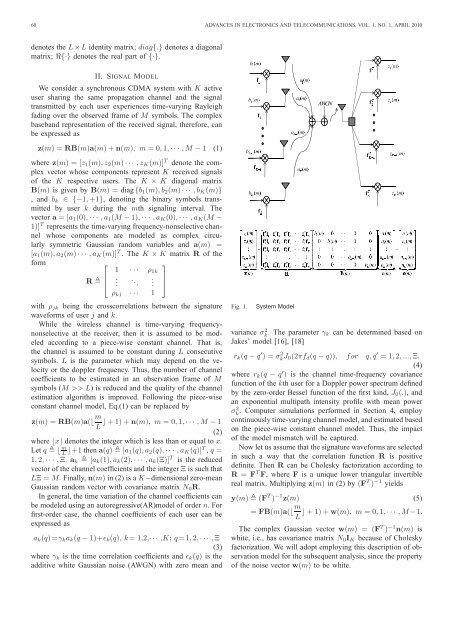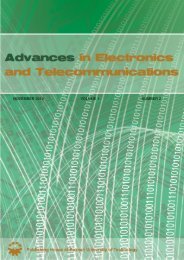channel - Advances in Electronics and Telecommunications
channel - Advances in Electronics and Telecommunications
channel - Advances in Electronics and Telecommunications
Create successful ePaper yourself
Turn your PDF publications into a flip-book with our unique Google optimized e-Paper software.
60 ADVANCES IN ELECTRONICS AND TELECOMMUNICATIONS, VOL. 1, NO. 1, APRIL 2010<br />
denotes the L × L identity matrix; diag{.} denotes a diagonal<br />
matrix; ℜ{·} denotes the real part of {·}.<br />
II. SIGNAL MODEL<br />
We consider a synchronous CDMA system with K active<br />
user shar<strong>in</strong>g the same propagation <strong>channel</strong> <strong>and</strong> the signal<br />
transmitted by each user experiences time-vary<strong>in</strong>g Rayleigh<br />
fad<strong>in</strong>g over the observed frame of M symbols. The complex<br />
baseb<strong>and</strong> representation of the received signal, therefore, can<br />
be expressed as<br />
z(m) = RB(m)a(m) + n(m), m = 0, 1, · · · , M − 1 (1)<br />
where z(m) = [z1(m), z2(m) · · · , zK(m)] T denote the complex<br />
vector whose components represent K received signals<br />
of the K respective users. The K × K diagonal matrix<br />
B(m) is given by B(m) = diag {b1(m), b2(m) · · · , bK(m)}<br />
, <strong>and</strong> bk ∈ {−1, +1}, denot<strong>in</strong>g the b<strong>in</strong>ary symbols transmitted<br />
by user k dur<strong>in</strong>g the mth signal<strong>in</strong>g <strong>in</strong>terval. The<br />
vector a = [a1(0), · · · , a1(M − 1), · · · , aK(0), · · · , aK(M −<br />
1)] T represents the time-vary<strong>in</strong>g frequency-nonselective <strong>channel</strong><br />
whose components are modeled as complex circularly<br />
symmetric Gaussian r<strong>and</strong>om variables <strong>and</strong> a(m) =<br />
[a1(m), a2(m) · · · , aK(m)] T . The K × K matrix R of the<br />
form<br />
⎡<br />
⎤<br />
R �<br />
⎢<br />
⎣<br />
1<br />
.<br />
· · ·<br />
. ..<br />
ρ1k<br />
.<br />
ρk1 · · · 1<br />
with ρjk be<strong>in</strong>g the crosscorrelations between the signature<br />
waveforms of user j <strong>and</strong> k.<br />
While the wireless <strong>channel</strong> is time-vary<strong>in</strong>g frequencynonselective<br />
at the receiver, then it is assumed to be modeled<br />
accord<strong>in</strong>g to a piece-wise constant <strong>channel</strong>. That is,<br />
the <strong>channel</strong> is assumed to be constant dur<strong>in</strong>g L consecutive<br />
symbols. L is the parameter which may depend on the velocity<br />
or the doppler frequency. Thus, the number of <strong>channel</strong><br />
coefficients to be estimated <strong>in</strong> an observation frame of M<br />
symbols (M >> L) is reduced <strong>and</strong> the quality of the <strong>channel</strong><br />
estimation algorithm is improved. Follow<strong>in</strong>g the piece-wise<br />
constant <strong>channel</strong> model, Eq.(1) can be replaced by<br />
z(m) = RB(m)a(⌊ m<br />
⌋ + 1) + n(m), m = 0, 1, · · · , M − 1<br />
L<br />
(2)<br />
where ⌊x⌋ denotes the <strong>in</strong>teger which is less than or equal to x.<br />
Let q � ⌊ m<br />
L ⌋+1 then a(q) � [a1(q), a2(q), · · · , aK(q)] T , q =<br />
1, 2, · · · , Ξ. ak � [ak(1), ak(2), · · · , ak(Ξ)] T is the reduced<br />
vector of the <strong>channel</strong> coefficients <strong>and</strong> the <strong>in</strong>teger Ξ is such that<br />
LΞ = M. F<strong>in</strong>ally, n(m) <strong>in</strong> (2) is a K−dimensional zero-mean<br />
Gaussian r<strong>and</strong>om vector with covariance matrix N0R.<br />
In general, the time variation of the <strong>channel</strong> coefficients can<br />
be modeled us<strong>in</strong>g an autoregressive(AR)model of order n. For<br />
first-order case, the <strong>channel</strong> coefficients of each user can be<br />
expressed as<br />
ak(q)=γkak(q − 1)+ǫk(q), k = 1,2,· · · ,K; q =1, 2, · · · , Ξ<br />
(3)<br />
where γk is the time correlation coefficients <strong>and</strong> ǫk(q) is the<br />
additive white Gaussian noise (AWGN) with zero mean <strong>and</strong><br />
⎥<br />
⎦<br />
Fig. 1. System Model<br />
variance σ 2 k . The parameter γk can be determ<strong>in</strong>ed based on<br />
Jakes’ model [16], [18]<br />
rk(q − q ′ ) = σ 2 kJ0(2πfd(q − q)), for q, q ′ = 1, 2, ..., Ξ.<br />
(4)<br />
where rk(q − q ′ ) is the <strong>channel</strong> time-frequency covariance<br />
function of the kth user for a Doppler power spectrum def<strong>in</strong>ed<br />
by the zero-order Bessel function of the first k<strong>in</strong>d, J0(.), <strong>and</strong><br />
an exponential multipath <strong>in</strong>tensity profile with mean power<br />
σ 2 k<br />
. Computer simulations performed <strong>in</strong> Section 4, employ<br />
cont<strong>in</strong>uously time-vary<strong>in</strong>g <strong>channel</strong> model, <strong>and</strong> estimated based<br />
on the piece-wise constant <strong>channel</strong> model. Thus, the impact<br />
of the model mismatch will be captured.<br />
Now let us assume that the signature waveforms are selected<br />
<strong>in</strong> such a way that the correlation function R is positive<br />
def<strong>in</strong>ite. Then R can be Cholesky factorization accord<strong>in</strong>g to<br />
R = F T F, where F is a unique lower triangular <strong>in</strong>vertible<br />
real matrix. Multiply<strong>in</strong>g z(m) <strong>in</strong> (2) by (F T ) −1 yields<br />
y(m) � (F T ) −1 z(m) (5)<br />
= FB(m)a(⌊ m<br />
⌋ + 1) + w(m), m = 0, 1, · · · , M −1.<br />
L<br />
The complex Gaussian vector w(m) = (F T ) −1 n(m) is<br />
white, i.e., has covariance matrix N0IK because of Cholesky<br />
factorization. We will adopt employ<strong>in</strong>g this description of observation<br />
model for the subsequent analysis, s<strong>in</strong>ce the property<br />
of the noise vector w(m) to be white.







